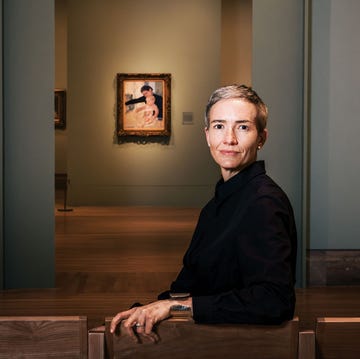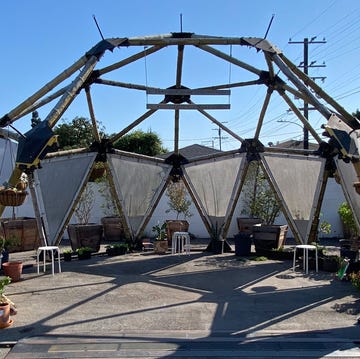Early in the summer of 1962, Howard Smith picked up the phone at his home in Philadelphia to find his friend José, an art dealer, on the line. “I know it’s late, and I’ll tell you more in the morning,” José began, according to Smith’s recollection years later, “but would you like to go to Finland within two weeks from now?” The call was a last-minute invitation to go work on Young America Presents, a U.S. cultural festival in Helsinki that included concerts and an art exhibition. Smith, who was then enrolled at the Pennsylvania Academy of the Fine Arts, and feeling increasingly frustrated by the ways he was being marginalized as a Black student, eagerly accepted the offer. Only later would he learn that the whole trip had been bankrolled by the Central Intelligence Agency.
The plan had been to go for six weeks. Smith ended up staying for most of the rest of his life. In the process, he became one of Finland’s most prominent artists and designers, known for distilling European modernism, African pattern, Japanese drawing, and Finnish design (to name a few of his inspirations) into a unique visual language that he deployed across mediums. He created brilliant textiles for the interior design house Vallila Silk Factory—a bold floral curtain in the late 1960s, named for South African singer Miriam Makeba, proved so popular that a version of that pattern remains in production today. For nearly a decade starting in 1986, he designed dishes and decorative objects for Arabia, Finland’s best-known ceramics company, including a collection of dishware and vases that synthesized African and modernist patterns into elegant geometric motifs. All the while, he maintained a prolific studio practice, creating murals, cut-paper collages, multimedia assemblages, quilted wall hangings, and a range of sculptures in ceramic and metal. In 2001, he was awarded Finland’s State Design Prize.
Yet for all his triumphs in Europe, Smith remains elusive in the United States, his country of birth—not to mention Los Angeles, where he lived for eight years starting in 1976. Google his name and you’re liable to turn up his ceramics on various resale sites. But unless you speak Finnish, detailed information is difficult to locate. When he died in 2021 at the age of 92, the lone U.S. notice of his passing appeared in a blog post by design curator Bobbye Tigerman on the website of the Los Angeles County Museum of Art. Independent curator Steven Wolf, who was introduced to Smith’s work by an L.A. design dealer about 20 years ago, says, “Nobody knows about Howard.”
This article appears in Issue 31 of Alta Journal.
SUBSCRIBE
That is changing. In 2023, Tigerman and curator Monica Obniski included Smith’s ’70s-era textile of radiant red irises in the exhibition Scandinavian Design and the United States, 1890–1980, which was presented at LACMA before traveling to the Milwaukee Art Museum. Last year, numerous works by Smith materialized in Nordic Utopia? African Americans in the 20th Century at the National Nordic Museum, in Seattle. This groundbreaking group show, recently on view at Scandinavia House: The Nordic Center in America, in New York, examined work by and about African American artists and musicians who spent formative periods in Nordic countries. And this May, the Palm Springs Art Museum will debut Smith’s first-ever U.S. retrospective, which was conceived and organized by Wolf. It will be accompanied by a full-color catalog published by Radius Books and will feature more than 130 objects made over his nearly six-decade career, including early collages and quilted works as well as his striking ceramic-tile grids, produced later in his life, composed of rows of geometric glyphs that read like rhythmic scores. After its Southern California debut, The Art and Design of Howard Smith will travel to the Espoo Museum of Modern Art, in Finland.
“It’s a pity Howard couldn’t see this,” says his widow, ceramist Erna Aaltonen, from the refurbished apple barn the couple shared as a home and studio in the village of Fiskars. “Especially, he hoped that Black people would see his work.”
The story of Howard Smith is about boundaries and a figure who continually transgressed them. It’s also a story about life and art being inextricable. Smith loved fashion and dancing and Mozart. “The happiness and also the sadness in his music,” says Aaltonen, “[Howard] just loved.” He was also an inveterate collector of objects that he liked to arrange in his living spaces: African masks, vintage farming tools, Korean ceramics, and modernist pottery. Amid all of this, you’d find his own work. In a 2022 oral history interview with the National Nordic Museum, Smith’s son, Erik Josef Howard Smith, describes his father’s home as a space that could have doubled as an art installation: “Whenever you visited Howard at his house, as you’re walking up the path, you’re seeing sculptures. As you get closer, the sculptures get more dense. As you’re entering the house, there’s just more and more of him around, and in the center is him. His art is just little fractions of him that spread out.”
“Everything he saw, he somehow put it in his mind and in his work,” says Aaltonen. “He would be sitting, and I could see that he was thinking and planning and planning.”
Smith’s artistic roots trace back to Moorestown, New Jersey, where he was born on April 17, 1928. His father, John Sylvester Smith, labored on a Quaker-run farm; his mother, Mary Anne McGregor, died when Howard was just two years old. With no one to mind the young boy at home, he was sent to school early. “Instead of getting books, I got paper, pens, pencils, crayons, things like that, and scissors,” Smith told Jussi Suomala, author of Howard Smith, an important monograph on the artist published in Finland in 2008. “So I started cutting and drawing, and I soon discovered that I liked to do that better than anything else.”
Paper became a particularly beloved material. As a kid, Smith went on a field trip to the Philadelphia Museum of Art, where he was wowed by Japanese and Chinese art. “That did it,” he said many years later. “When I saw what magic paper can do with ink, I said, ‘This is just wonderful.’ So I, very early on, dismissed this thing about holy oil and I fell in love with the paper.” Smith worked with many materials over his life, but paper and scissors remained foundational throughout.
Smith spent his 20s as a corporal in the U.S. Army, serving in an information office at a base near Sendai, Japan, followed by deployments to Korea and West Germany. All the travel fed his increasing interest in art and design; he was a consummate aesthete. During his military deployment in Japan, he devoted his free time to investigating antique shops and museums. In West Germany, he became enamored with the Würzburg Residence, a magnificent baroque palace that had survived World War II. “It was absolutely unbelievable,” he once said. “It was as if the garden had been created for the nightingale.” In Würzburg, he also enlisted the help of local craftspeople to create bespoke fashion pieces for his closet, including ornate vests and snakeskin shoes. As he told Suomala, “I was quite a dandy back then.”
After his discharge in 1958, Smith moved to Philadelphia to live with his sister, Lucille, and pursue his artistic studies at the Pennsylvania Academy of the Fine Arts, where he was admitted on the strength of his collage work. But his return to the United States was dispiriting. The school was conservative in its approach to teaching art, and the artist also grappled with crass racism. He was 34 and had traveled the world, yet was still shut out of social events, like a departmental dinner at a faculty member’s home, because he was Black. As he told Samella Lewis in a 1976 interview in Black Art: An International Quarterly, “I was at an impasse.”
Ironically, it was the rigid politics of the Cold War that opened a door.
In the blustery face-off between the United States and the Soviet Union, Finland was officially neutral. But it occupied politically fragile territory—the country shares a more than 800-mile border with Russia—at a politically fragile moment. In 1961, rising tensions had led to the construction of the Berlin Wall and the division of the city. So when the organizers of a biennial Soviet-sponsored youth festival announced that Helsinki would be the site of the 1962 gathering, alarm bells went off in Washington, D.C. The United States responded by staging Young America Presents in Helsinki during the same period. The one-time festival included an exhibition of modern art and architecture as well as daily jazz concerts led by notable musicians like pianist Herbie Nichols and clarinetist Jimmy Giuffre—all of it secretly financed by the CIA and all of it part of a larger Cold War effort to counter the Soviet presence with the most avant-garde artifacts of American culture. Historians Joni Krekola and Simo Mikkonen write in the Scandinavian Journal of History that the competing festivals turned Helsinki in the summer of ’62 into “a centre of extensive Cold War operations.”
Smith found himself in the middle of those operations. As he told Suomala, “I was brought here by the CIA, you understand? Unknowingly.”
The CIA may have gotten him to Finland, but it was a testament to his vision that he remained. What type of work Smith did for Young America Presents isn’t documented, but what is certain is that he caught the eye of an ad executive named Matti Viherjuuri, who invited him to stay. Viherjuuri gave Smith a part-time job teaching conversational English to his employees and offered to arrange an exhibition of his work. Locating the earliest pieces that Smith produced in Finland was a challenge, but Wolf was able to track down a pair of collages the artist created in 1967, which combine historical images harvested out of old publications with elements that were painted by hand.
In Finland, Smith’s work grew in ambition and scale. As he told Black Art, “it was the first time in my life that I felt a real, free man.” By the mid-1960s, Smith had expanded his material range. “He’s creating textile assemblages and textile collages and found-textile collages,” says Wolf. “You see his fluidity in media and his willingness to not be confined by the traditional categories of art making.” An untitled appliqué piece from around 1968 shows a black hand wiping away the tear of a birdlike creature rendered in green—it’s a poignant, unusual composition.
One of the artist’s most powerful pieces from this era is a mixed-media collage from 1965 titled America? Serving as background is a series of red, black, and white squares nestled one inside the other (à la Josef Albers); in the foreground stands the silhouette of a Black figure. An early version included a piece of rusty chain adhered to the surface, which Smith later removed. “This work was done at and after the Montgomery Riots,” he wrote on the back of the canvas, referring to the 1961 attacks on civil rights marchers by white mobs in Alabama. The question mark captured the ambivalence Smith felt toward his native country. Among other indignities, he’d once been arrested trying to gain entry to his own home in Philadelphia after forgetting his keys.
Finland, however, was not without challenges. For one, there was his personal life. In 1965, Smith had married Raili Hakulinen, a Finnish woman who worked in television production, and the pair had two children together: Erik and a daughter, Satu Marja Lucille. By the early ’70s, though, the marriage was falling apart. Furthermore, while Finland had been very welcoming to Smith professionally—he was collaborating with architects on interior design projects and doing commercial work for Vallila—he still faced exoticization and racism, as well as the loneliness that comes with being Black in an overwhelmingly white country. Leslie Anne Anderson, who cocurated Nordic Utopia?, explains that this was not uncommon among African American expats in the region, such as saxophonist Dexter Gordon and pianist Duke Jordan, who moved to Denmark during the 1960s and ’70s. “The Nordic countries offered them creative freedom,” she says. “But among the artists, there were comments about feelings of isolation.”
All of this led Smith to come back to the United States in 1976, ultimately settling in Los Angeles. “I need the spiritual input, I guess, of being around Black people,” Smith told Lewis in Black Art shortly after his return. Lewis helped him secure a teaching gig at Claremont College and exhibition opportunities. A show of his appliqués, metal sculptures, and masks—which Smith crafted out of found objects like hats and old purses—opened at the Clark Humanities Museum at Scripps College in 1978 and garnered a small write-up in the Los Angeles Times. Smith remained a prolific artist during this period, producing masks as well as textiles and prints that reflected his increased interest in African themes. But he never fully enmeshed himself in the Black arts scene in Southern California. The Brockman Gallery, run by brothers Dale and Alonzo Davis, was an important hub for Black artists in L.A. at the time, yet Smith never showed there. (Reached via email, Dale couldn’t recall ever having any conversations with the artist.) The lack of connection could have been over aesthetics—many U.S. artists in the ’70s had taken more conceptual and political turns at a moment when Smith remained preoccupied with the field of commercial design. But it could also be that after more than a dozen years in Finland, Smith was no longer fully American. Says Wolf, “He was almost like a Finnish expatriate in America.”
Lewis’s son Claude Lewis, who took Smith around L.A. on various errands and on missions to thrift stores, says he remembers being surprised when he learned that Smith was from the United States. “It was a shock to me,” he says, “because he seemed like he was from Finland.” Lewis recalls an eccentric, avuncular figure who reimbursed him for his time with a pair of elaborate vests. “I’d be driving him around, and I’d be playing my music. I remember playing War, and he would be like, ‘Who is this lovely singer?’ ”
Ken Erwin, a prominent L.A. design dealer, became close friends with Smith after the pair met at a vintage design store on Melrose Avenue—the sight of another Black man at a design shop serving as a point of instant connection. He recalls Smith’s frustrations with the L.A. art scene—“He couldn’t really get any traction here in the States”—along with the difficult decision to return to Finland. Erwin accompanied Smith on the journey back to Helsinki in 1985. “I’ll never forget this: We’re walking down the street, and a guy comes running up and hugs Howard, and he says, ‘Mr. Smith! I thought you were dead! Where have you been?’ Howard explains that he’d been in the United States. And the guy said, ‘Welcome home!’ ”
Finland would remain Smith’s home for the rest of his life. Within a year of his return, he landed a prestigious residency at Arabia ceramics, where he met Aaltonen, who was then working in the company’s color laboratory. “He was a very kind and very charming person,” recalls Aaltonen, who says she was drawn to Smith’s work for its unique iconography. “It was something I had not seen.” Together, they established a small artisanal ceramics factory called Arteos in Tervakoski, about an hour north of Helsinki, before ultimately relocating to Fiskars. They wed in 1991.
Smith’s second tenure in Finland was as productive as the first. The work for Arabia led him to expand his artistic practice into ceramics, and the ample studio space in Fiskars also allowed him to experiment with large-scale sculpture made from found metal. What is most striking to me about his work during this period, however, is the way in which glyphs became a pervasive part of his art—either in cut-paper collages or as a decorative motif in his ceramic-tile grids. In some of these compositions, the forms are fully abstract; in others, they evoke letters. It’s as if this artist, caught between cultures, was devising his own alphabet, his own language, his own unique way of speaking.
“There was a period where Howard was forgotten,” says Aaltonen. “But young people are again interested in his work. They find him, and they’re like, ‘Wow! I like this! I never knew about this man.’ ” In the exhibition catalog, the young fashion designer Ervin Latimer has a moving essay about what it has meant to him to discover Smith’s work, as the biracial son of an African American father and a white Finnish mother.
More than six decades after Smith made his life-changing journey, the artist and his unique language are now coming into focus. “It’s overdue,” says Wolf. “Howard was this guy who had an incredible skill set and incredible ambition, and he was fearless.”•
THE ART AND DESIGN OF HOWARD SMITH
May 10, 2025—Mar. 2, 2026
Palm Springs Art Museum
101 Museum Dr., Palm Springs
psmuseum.org






















